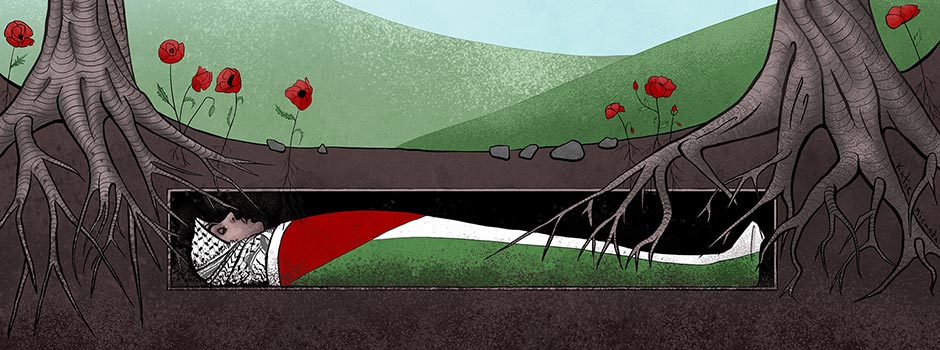
An Interview with Muslim-American Artist Katie Miranda Natural Meanderings in Many Media
Sep 30, 2019 FEATURE, Interview

Katie Miranda Al Ali is committed to illuminating beauty and truth through the mediums of painting, comics, and Arabic calligraphy jewellery. Passionate about art, the artist studied at the Academy of Art University in San Francisco, receiving both a BFA and an MFA. From 2005-2008, Katie lived in the West Bank cities of Hebron and Ramallah both volunteering as a human rights worker with the International Solidarity Movement and studying Arabic calligraphy with award-winning Palestinian calligrapher Ehab Thabet. Upon her return to the US, she began exploring jewellery making, took her shahadah, and created Katie Miranda Studios where she designs sterling silver calligraphic jewellery, draws cartoons and paints. Katie Miranda has exhibited her art both at home and abroad, including at the Sharjah Capital of Islamic Culture festival in the United Arab Emirates in 2014. Her illustrations have appeared in many publications like the Middle East Eye, Mondoweiss, Dissident Voice, The Middle East Monitor and The Electronic Intifada.
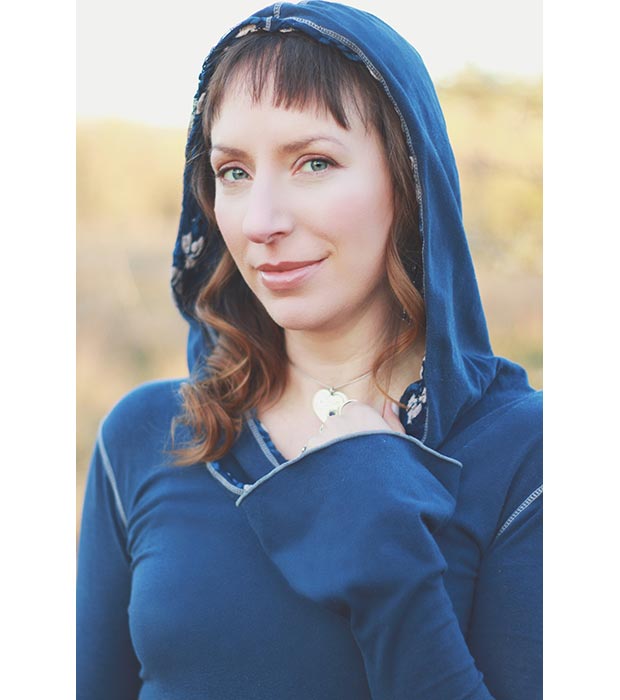 Katie Miranda Al Ali / Courtesy of the artist
Katie Miranda Al Ali / Courtesy of the artist
I have about 15 years of work on show, including fine art, illustration, jewellery, and cartoons on the subject of Palestine. The title of the show is “Sumoud w Todamon†which translates to “Steadfastness and Solidarity.†I started creating art on this subject in late 2005 when I first visited Palestine to volunteer as a human rights worker. I stayed there for three years, landing a job as a cartoonist at a local paper after I became too traumatized to do the work with the International Solidarity Movement anymore. Eventually, I came back to the US but the struggle, the people, the land didn’t leave me. It’s a subject that is inspirational to me. My first output was a series of 9 x 12 inch illustrations in acrylic paint of people or situations I experienced that I called “Postcards from Palestine.†(acrylic on canvas, 9 x 12 inches 2006-2007) The illustration was the front of the postcard and then I had accompanying text on the backs which consisted of letters addressed to the American people. It was my version of “the weather is nice; wish you were here,†except it wasn’t nice at all; it was very violent and very disturbing. After I returned to the US, I started submitting political cartoons to various news sites and sometimes they got published.
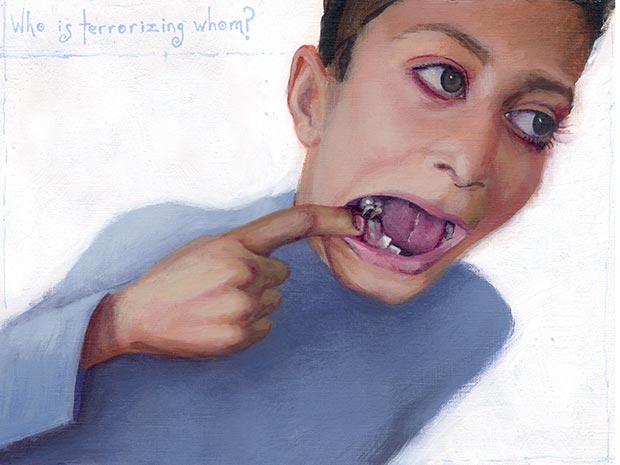 Katie Miranda, “Postcard of Yusef from Tel Rumeida,†from Postcards from Palestine series, acrylic on canvas, 2006, front / Courtesy of the artist
Katie Miranda, “Postcard of Yusef from Tel Rumeida,†from Postcards from Palestine series, acrylic on canvas, 2006, front / Courtesy of the artist
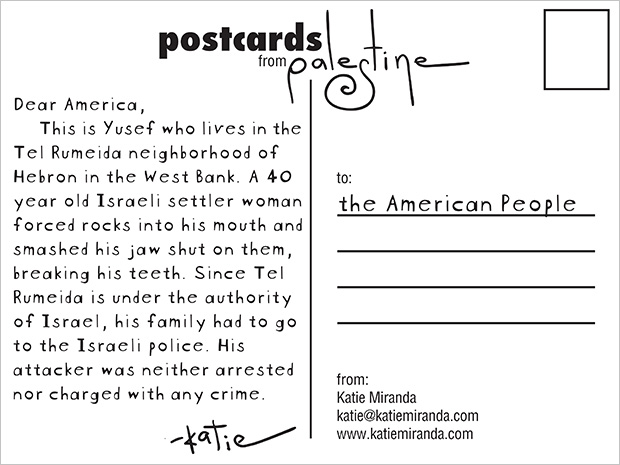 Katie Miranda, “Postcard of Yusef from Tel Rumeida,†from Postcards from Palestine series, acrylic on canvas, 2006, back / Courtesy of the artist
Katie Miranda, “Postcard of Yusef from Tel Rumeida,†from Postcards from Palestine series, acrylic on canvas, 2006, back / Courtesy of the artist
To be clear there are only two paintings so far with a biblical theme, although I was hoping to do more. I want to do an Annunciation, a David and Goliath, and a Madonna and Child, but I paint in a very detailed manner and so the works take a long time. It’s also incredibly expensive to create a painting. You have to pay models —and sometimes a photographer— if you want certain lighting conditions. I spent close to $500 on the photography, models, and supplies for the “Pietà †(oil and acrylic on canvas, 20 x 20 inches, 2019) painting that took me four months to paint.
Last year, I was raptly listening to Jordan Peterson’s biblical lecture series. He goes deeply into the psychological significance of the biblical stories, stories that are the basis for Judaism, Christianity, and Islam. Since I have a connection to all three religions, both as a convert to Islam and as someone with a mixed Jewish and Christian heritage, I was deeply fascinated with Peterson’s take on the Book of Genesis. He interweaves the stories with what science has discovered about human evolution and biology. Part of his presentations included slides of Renaissance biblical art, which brought me back to my university art history lessons, albeit with a new perspective. These lectures inspired me to return to biblical themes and to juxtapose them with the situation that modern-day Palestinians face. These are ancient themes, pre-biblical themes even, that still have significance in modern times. That’s why people are still drawn to them.
Already in 2004, I had an idea in my head to paint a Pietà on the apartheid wall (acrylic on apartheid wall, 2006) and, fortunately, I was able to realize that dream. Unfortunately, the mural was spray painted over with lots of graffiti and I've wanted to redo it ever since. This next part was published on my blog “I was particularly motivated by the tragic loss of precious lives during the Great March of Return. One feels very helpless on the other side of the world, watching people being massacred for participating in demonstrations which, had they taken place where we live, would not have been met with such lethal force. Those of us living in liberal democracies should never take for granted the hard-won freedoms we have.
While painting Mary’s scarf, I couldn’t help but think of western society’s obsession with Muslim women’s hijab, especially as western art is full of images of Mary with her hair covered and, yet, no one bats an eye. But in western society, a woman covering her hair can be the subject of pity, ridicule, contempt and, as in France, with its legislation against the hijab. Yet all the great religious art of Europe, for millennia, depicted women with their hair covered.â€
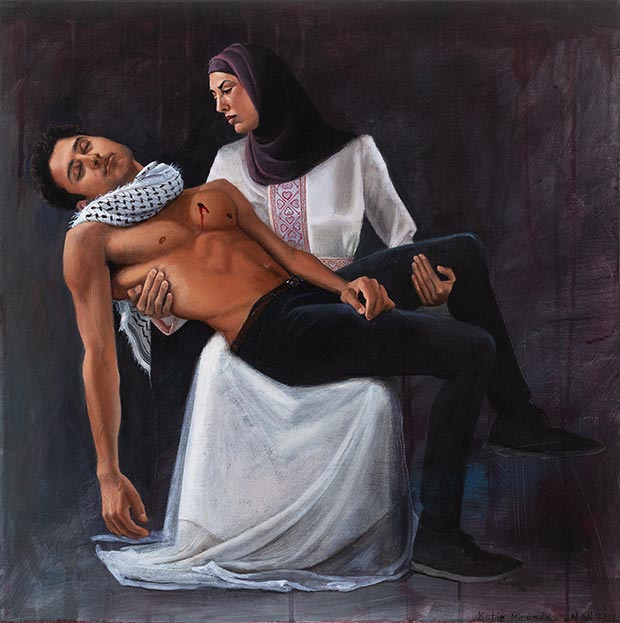 Katie Miranda, Pietà , oil and acrylic on canvas, 20 x 20 inches, 2019 / Courtesy of the artist
Katie Miranda, Pietà , oil and acrylic on canvas, 20 x 20 inches, 2019 / Courtesy of the artist
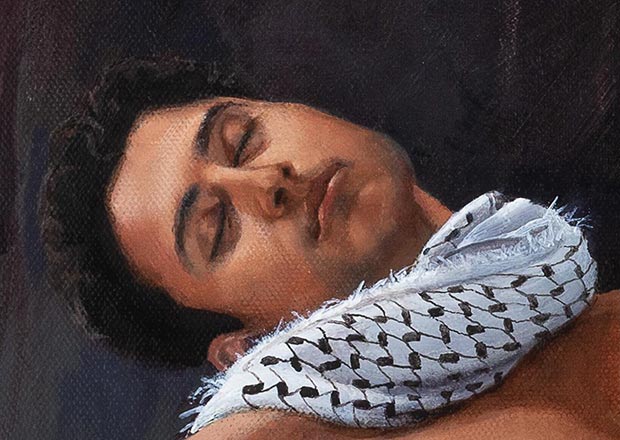 Katie Miranda, Pietà , oil and acrylic on canvas, 20 x 20 inches, 2019, detail / Courtesy of the artist
Katie Miranda, Pietà , oil and acrylic on canvas, 20 x 20 inches, 2019, detail / Courtesy of the artist
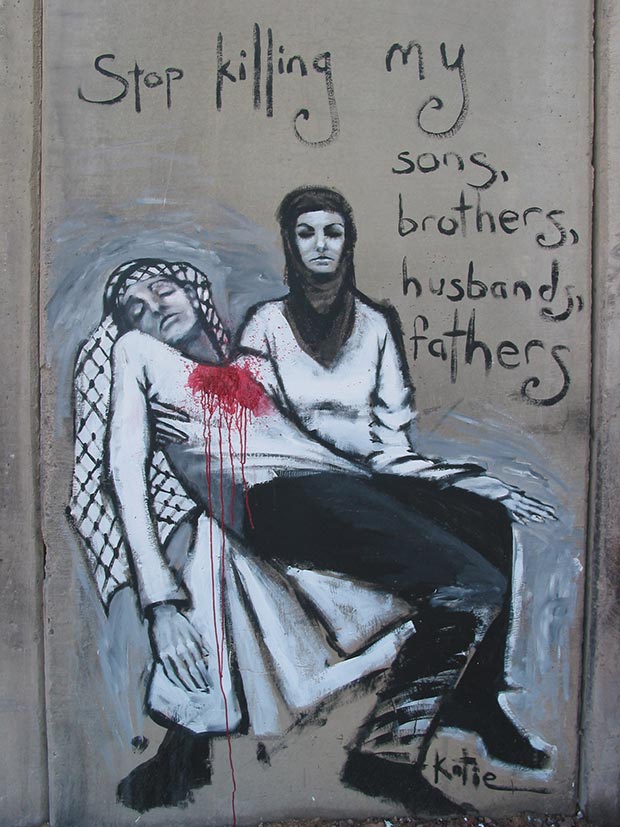 Katie Miranda, Pietà on Apartheid Wall,Qalandia checkpoint, 2006. / Courtesy of the artist
Katie Miranda, Pietà on Apartheid Wall,Qalandia checkpoint, 2006. / Courtesy of the artist
I guess I’m a straightforward kind of gal... The work is actually very similar to my earlier paintings, but painting is not really what I’m know for lately. Salvator Mundi, the man in traditional dress holds a key to the home in his ancestral village and a globe that confronts the viewer with the United States highlighted on it, reflecting that the key to liberation is hopelessly tied up in American politics. I stopped painting for about six years, simply because I didn’t think there would be a market for my paintings. Then I started up again recently with the attitude that I don’t care if people buy them or not because painting is my first and true love, above cartoons, calligraphy, or jewellery. I prefer painting to anything else. It’s also what I’m best at.
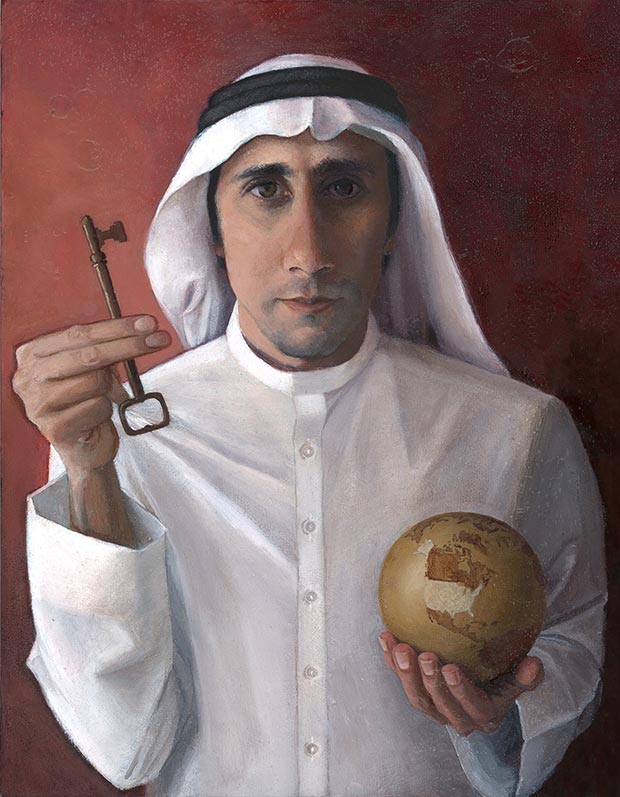 Katie Miranda, Salvator Mundi, oil on canvas, 20 x 20 inches, 2019 / Courtesy of the artist
Katie Miranda, Salvator Mundi, oil on canvas, 20 x 20 inches, 2019 / Courtesy of the artist
This digital painting has a history which started in 2006 while I was volunteering with the International Solidarity Movement in occupied Palestine. We were sent to Balata refugee camp because the Israeli army had invaded and was shooting up the place. The army had announced a curfew on the whole camp which meant that any Palestinian caught in the street would be shot. We, as internationals, were not supposed to be shot so we delivered food and medicine to needy people who could not go out. The next day there were two martyrs, killed by the Israeli army: Ibrahim Issa and Mohammed Natoor, both 17. They had been drinking tea on their roof when the Israeli army shot them. We watched their funeral procession from a balcony the following day. The way I coped with the horror around me was to draw and paint. Over the next few days I completed the drawing below in ballpoint pen. The writing says "the blood of the martyrs will fertilize the earth" which was inspired by a Diego Rivera mural of the same name. It was spring time in Palestine and flowers were blooming, the weather was beautiful, the sky was blue; a stark contrast to the death and mayhem. I kept repeating over and over in my head "this place is so beautiful, but so horrible, but so beautiful, but so horrible." I showed the drawing to some people in the camp. One man had recently lost his brother to the Israeli army and he asked me to paint it as a mural on his house which I did. I always knew this concept had the potential to be better and so I decided to redo it digitally and now that I know calligraphy, to make it even better.
 Katie Miranda, The Blood of the Martyrs Will Fertilize the Earth, Drawing, ballpoint pen on paper, 9 x 12 inches, 2007 / Courtesy of the artist
Katie Miranda, The Blood of the Martyrs Will Fertilize the Earth, Drawing, ballpoint pen on paper, 9 x 12 inches, 2007 / Courtesy of the artist
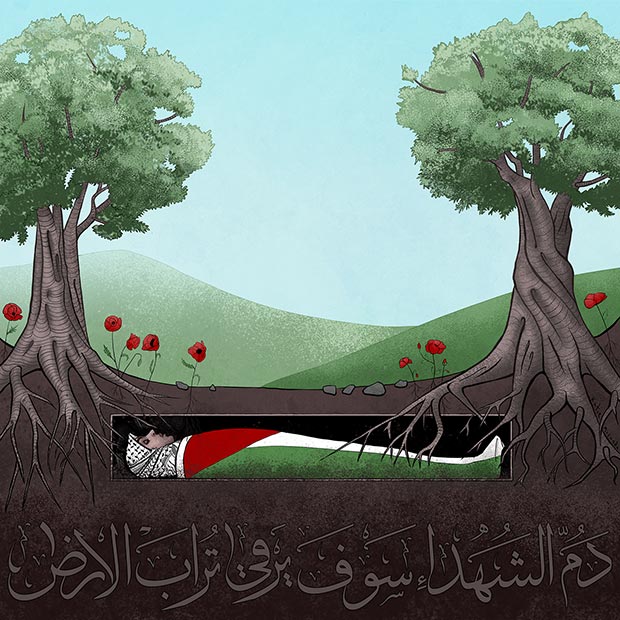 Katie Miranda, The Blood of the Martyrs Will Fertilize the Earth, Drawing, digital painting, 2019 / Courtesy of the artist
Katie Miranda, The Blood of the Martyrs Will Fertilize the Earth, Drawing, digital painting, 2019 / Courtesy of the artist
There’s the old cliché question, ‘does life imitate art or does art imitate life?’ Oscar Wilde famously said “that the self-conscious aim of Life is to find expression, and that Art offers it certain beautiful forms through which it may realize that energy.†I am forever traumatized by what I saw in Palestine and that trauma is expressed through art. The art —perhaps naively— hopes that someone will pay attention to it and take action in their own way. I am fortunate that I have art as an outlet as many activists I knew turned to smoking, drinking, and drugs to suppress their trauma. And that’s to say nothing of the Palestinians who have lived their whole lives there. What do they do with their trauma? Those of us fortunate to live outside of conflict zones can choose to continue to participate in the struggle in a number of ways. You can go to a demonstration. You can organize. You can fundraise. Personally, organizing, demonstrations, and meetings bore me to tears and so I’m left with artistic expression.
I also find that long format interviews are incredibly worthwhile. While working, I consume hours upon hours of listening to people I don’t know talking about subjects from psychology to economics to politics on the internet. I’m attempting to do the same thing with my podcasts about Palestine. A bonus is that I get to chat with people I’d never have an opportunity to chat with in real life. I do engage in some more concrete action too, like the nonprofit called Palbox that I started in 2015 that involves a quarterly subscription box featuring crafts from Palestine, organic, fair trade Palestinian food, and my own jewellery.
 Katie Miranda, “Trying to argue with someone who doesn’t share your point of view,†drawn for Mondoweiss, 2018 / Courtesy of the artist
Katie Miranda, “Trying to argue with someone who doesn’t share your point of view,†drawn for Mondoweiss, 2018 / Courtesy of the artist
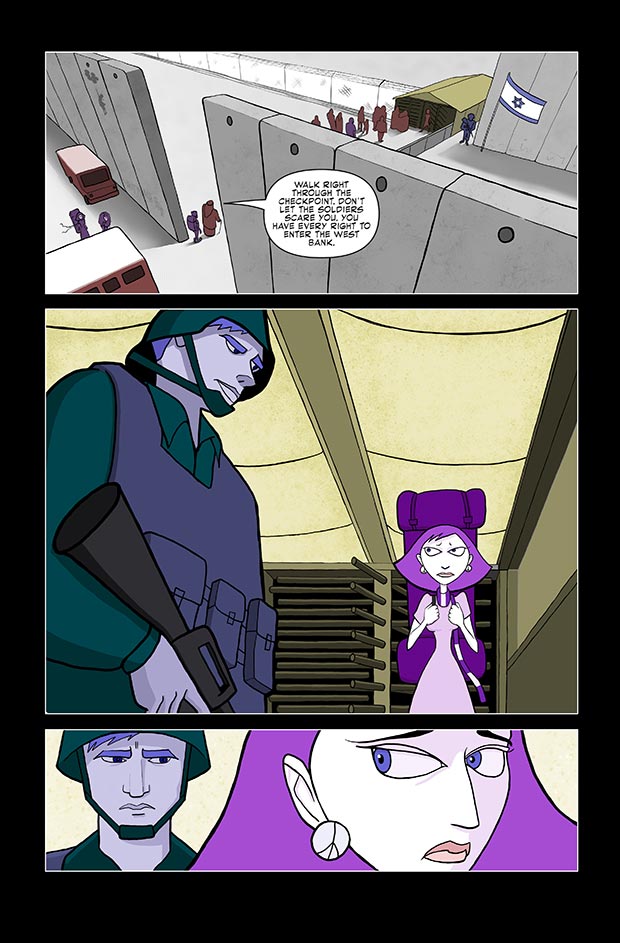 Katie Miranda, Page from Tear Gas in the Morning digital drawing, 2011 / Courtesy of the artist
Katie Miranda, Page from Tear Gas in the Morning digital drawing, 2011 / Courtesy of the artist
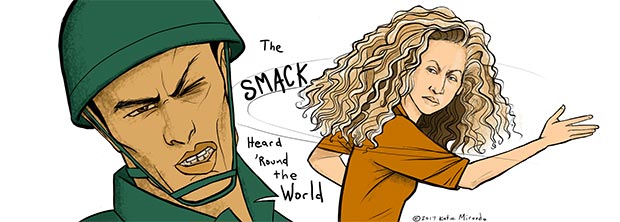 Katie Miranda, The Smack Heard Around the World, digital cartoon, 2018 / Courtesy of the artist
Katie Miranda, The Smack Heard Around the World, digital cartoon, 2018 / Courtesy of the artist
When I was getting my Master’s Degree in illustration at the Academy of Art University, I had to take an elective so I chose metalsmithing. I had studied Arabic calligraphy in Palestine with a calligrapher named Ehab Thabet and I thought it would be fun to try to combine the two art forms. My first attempt was crude. I wrote some calligraphy that said “Palestine†and traced it onto a piece of sterling silver sheet metal. Then I took a hacksaw and cut the letters out. I added some semi-precious stones, including a stone replacing the dot in the Arabic letter noon ن.The execution was crude, but the concept was pretty cool. Next, I taught myself photochemical etching, which is a process where you use acid to dissolve unprotected parts of a metal surface. This was an improvement, but the letters were still not crisp and clean like they are when you use a calligraphy pen. I sold a few of these on Etsy and people seemed to like them. I needed to improve the product so I experimented with 3D printing and metal stamping. Stamping produced the cleanest and most consistent results, so that’s what I’ve stuck with.
At first, I started making Islamic jewellery that said Allah, Muhammed, and Ali. That received criticism from some quarters because people don’t want to wear them into the bathroom. The Ali necklace, in particular, really made people mad. At the time, I was a new Muslim and I wanted to be inclusive of Shia Muslims so I made an Ali necklace. I still don’t understand why it made people mad. One time a famous musician whom I greatly admired stopped by one of my booths when I was selling jewellery at a festival in San Francisco. He zeroed in on the Ali necklace to the exclusion of the rest of my work and asked me angrily why I had this here. I was so flustered because of course I was excited that someone I admired was looking at my jewellery and I have no idea what I said in response but it left me very upset because I had no idea why he was so angry. It left an impression, so I moved away from Islamic themes, towards themes of positivity because it’s hard to get angry about words like love, peace, hope and faith. We all need more of that in our lives! When I started doing the jewellery, it was the era when people were getting kicked off planes for reading books in Arabic and that pissed me off. It’s such a beautiful written language and I wanted to take that and put it in people’s faces, literally. I wanted people to say “what language is that, what does that say?†and for them to then confront their preconceived notions. Plus, there’s so much chaos and negativity in the world. I want to counter that and create objects that people are excited to put on, that make them feel good about themselves! One person can change the world with a bit of hope and faith, which are two of my more popular jewellery themes. The feedback I get from my customers is positive and I am appreciative of that.
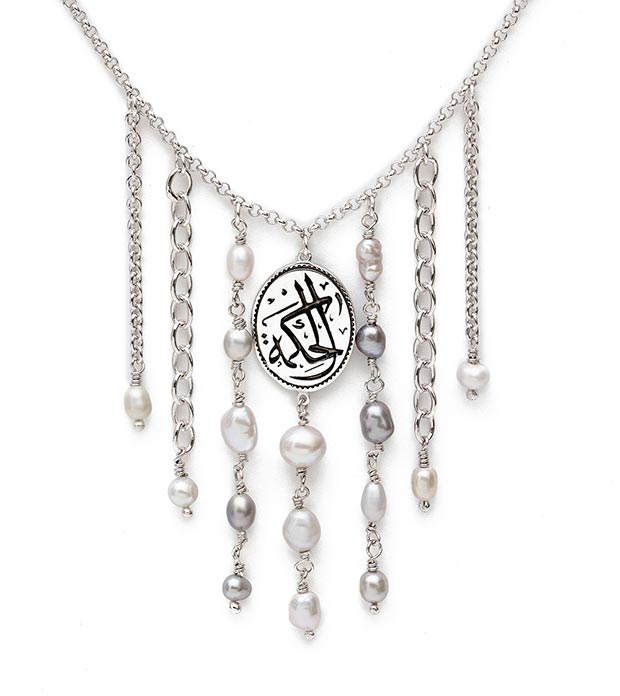 Katie Miranda, Wisdom (Hikmah) Necklace, sterling silver with cultured freshwater pearls / Courtesy of the artist
Katie Miranda, Wisdom (Hikmah) Necklace, sterling silver with cultured freshwater pearls / Courtesy of the artist
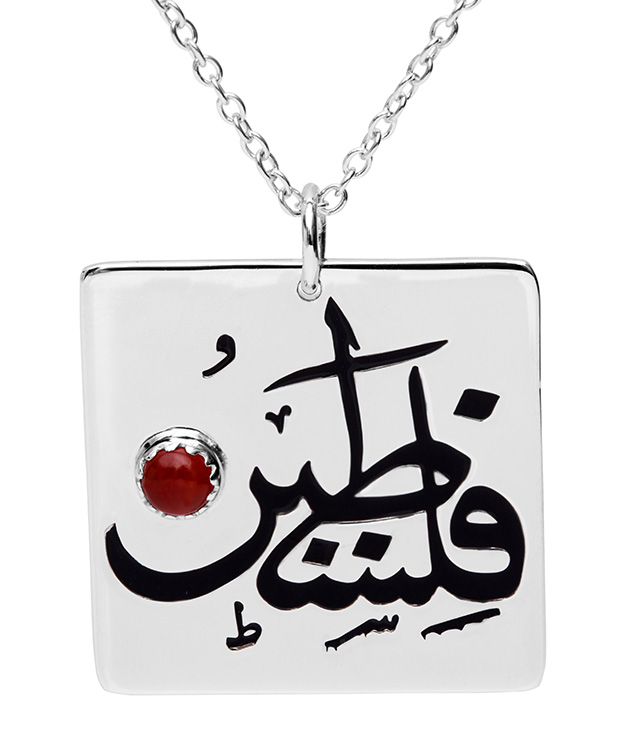 Katie Miranda, Palestine Necklace sterling silver with a carnelian stone / Courtesy of the artist
Katie Miranda, Palestine Necklace sterling silver with a carnelian stone / Courtesy of the artist
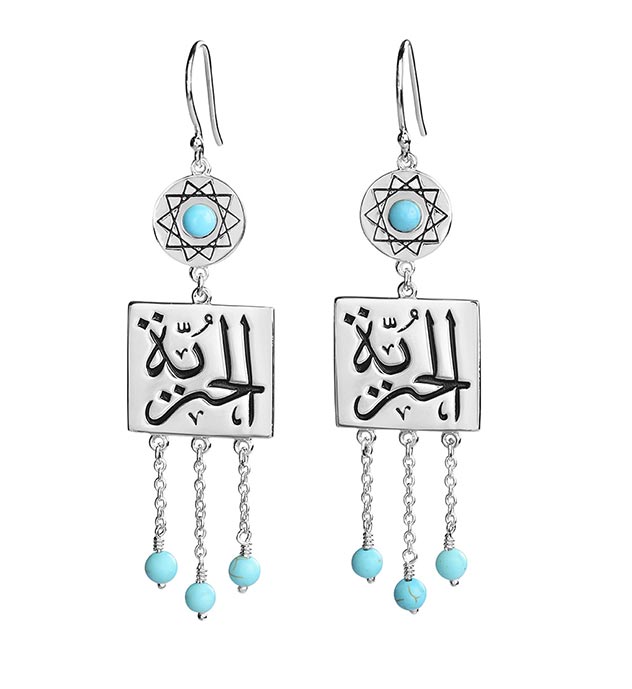 Katie Miranda, Freedom (Huriyyah) Earrings, sterling silver with turquoise / Courtesy of the artist
Katie Miranda, Freedom (Huriyyah) Earrings, sterling silver with turquoise / Courtesy of the artist
I’ve been working on a graphic novel about Palestine since 2007. You don’t get paid to draw a graphic novel unless you’re already a well-known comics artist, so I have to work on it in my spare time. I’ve drawn about 70 pages and I think it will be about 300 pages long and I therefore don’t know how long it’s going to take. I’m baffled how people complete these with no pay. I know that people who draw for Marvel, DC, or any of the major book publishers that also print graphic novels receive advance payments. However, Marvel or any other mainstream publishers are not going to publish something sympathetic to Palestinians; that is clear. I have submitted to many publishers and agents and, while I was offered two opportunities, they would have not have paid the bills for the year needed to get it done if I worked on it full time. So, I will keep plugging away at it…
Comments
Add a comment